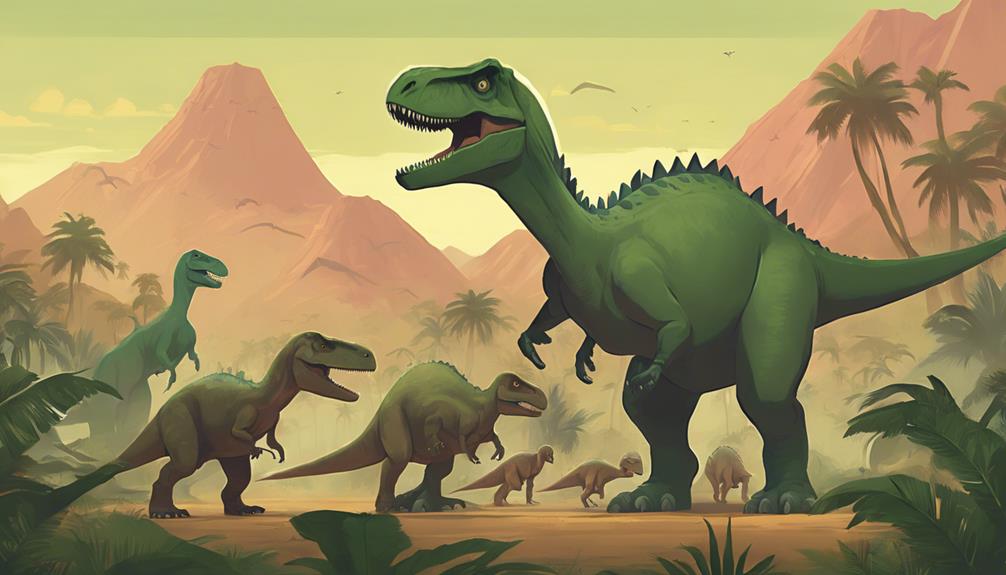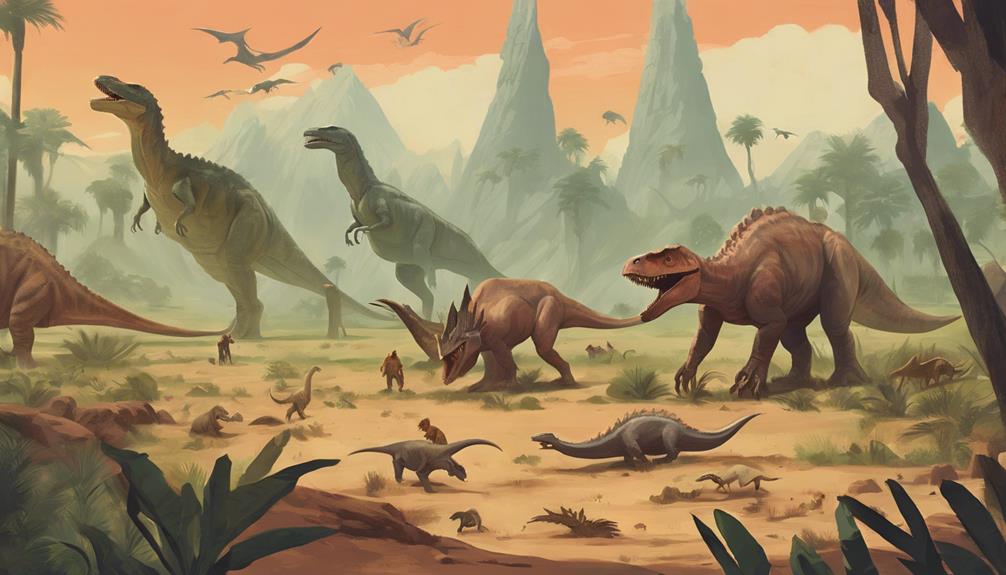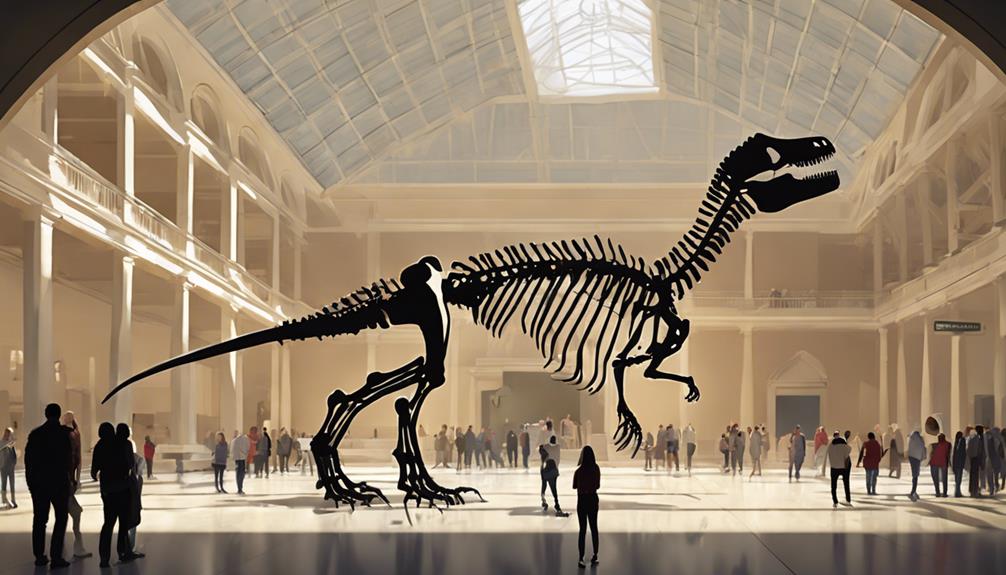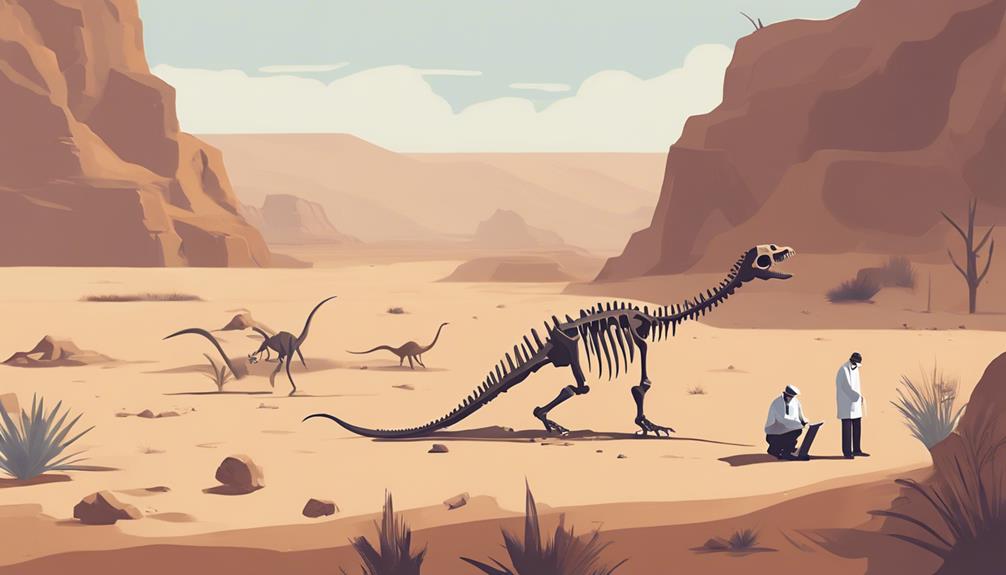Summary
- 1 The Evolutionary Meaning of Dinosaurs.
- 2 Dinosaurs as indicators of climate change
- 3 Role of Dinosaurs in the Balance of Ecosystems.
- 4 Lessons from dinosaur extinction events
- 5 Cultural impact of dinosaurs in society
- 6 Dinosaurs as ancient ambassadors of the Earth
- 7 Implications of dinosaur discoveries
- 8 Frequently asked questions
The dinosaurs, those colossal creatures of the past, carry immense importance in the Earth's evolutionary history and influence various aspects of our world today. These ancient giants were more than just impressive reptiles; they influenced the development of numerous species and ecosystems over millions of years. Their existence shaped a new era, shaping life as we know it. If you are curious to learn more about their evolutionary role, the importance of climate change, and the lessons of extinction events, their impact resonates far beyond their immense footprints In the sediments of time.
The Evolutionary Meaning of Dinosaurs.

Dinosaurs played a crucial role in shaping the evolutionary path of life on Earth, profoundly influencing the development of various species over millions of years. These magnificent creatures were not just massive reptiles; they were the architects of a new era. Imagine a world in which dinosaurs roamed, dominating the land, skies and seas. Their existence was not just a spectacle; it was a transformative force that influenced the course of evolution.
As dinosaurs evolved and diversified, they caused significant changes in ecosystems. Their impressive size and adaptations led to the evolution of other organisms, prompting them to develop new survival strategies. For example, the rise of flowering plants is believed to have been influenced by the feeding habits of some herbivorous dinosaurs. Basically, dinosaurs were the catalysts for a cascade of evolutionary events that shaped the world we know today.
Dinosaurs as indicators of climate change
Have you ever wondered how dinosaurs can give us clues about climate change? Well, dinosaur fossils offer valuable information about ancient climates, helping us understand how environmental conditions changed over millions of years. By studying the prehistoric environments in which dinosaurs lived, scientists can unravel the mysteries behind their extinction and how climate played a role in shaping Earth's history.
Dinosaur fossil Climate
Dinosaur fossils found encapsulate valuable insights into the ancient climates they inhabited, serving as indicators of past environmental changes. By analyzing these fossils, scientists can uncover a wealth of information about climate during the dinosaur era. Here's how dinosaur fossils help us understand prehistoric climates:
- Growth Rings: Similar to tree rings, dinosaur bones may have growth rings that provide information about the age of the animal and the environmental conditions in which it lived.
- Isotope analysis: Isotopes in dinosaur bones can reveal details about temperature, precipitation and even the types of plants in the ecosystem.
- Geographical distribution: Studying where different dinosaur species lived can provide clues about climate zones and environmental diversity during their time.
- Adaptive features: Physical characteristics of dinosaurs, such as body size or the presence of special features such as plates or ridges, may indicate how they adapted to climatic variations.
Understanding past climate through dinosaur fossils helps us piece together the puzzle of ancient ecosystems and how they have changed over time.
Changes in the prehistoric environment
By studying the evolution of prehistoric environments, dinosaur fossils are valuable indicators of past climatic changes, offering a glimpse into the dynamic landscape of ancient ecosystems. By examining the distribution of different dinosaur species and the types of plants they ate, scientists can infer the predominant climatic conditions of these past eras. For example, the presence of certain dinosaur species in regions that are now arid deserts suggests that these areas were once lush and wet. Similarly, the size and shape of dinosaur bones may indicate whether they lived in warmer or colder climates.
In addition, the study of isotopes found in dinosaur teeth may reveal information about the temperature and water sources of their habitats. Changes in these isotopic signatures over time can paint a picture of how climates shifted during the Mesozoic Era. By combining these clues from dinosaur fossils, researchers can better understand the historical environmental changes that shaped the world millions of years ago.
Clues to the extinction of dinosaurs
Dinosaurs provide valuable insights into climate change through their fossils and isotopic signatures, shedding light on environmental conditions that may have contributed to their extinction. Here's how they do it:
- Fossil Registry: By studying dinosaur fossils, scientists can determine the types of plants that existed during the dinosaur era. Variations in plant fossils suggest changes in climate patterns.
- Isotopic Signatures: Isotopes found in dinosaur bones can reveal information about ancient climates. For example, oxygen isotopes can indicate changes in temperature.
- Geological Evidence: Dinosaur remains found in different parts of the world help scientists reconstruct past environments. Clues such as sediment layers and rock formations provide perspectives on ancient climates.
- Models of Biodiversity: The distribution of dinosaur species among regions may highlight climatic and habitat changes. Variations in biodiversity may signal environmental transformations that may have influenced dinosaur populations.
Role of Dinosaurs in the Balance of Ecosystems.

Understanding how dinosaurs contributed to the balance of ecosystems can provide valuable perspectives on prehistoric environmental dynamics. Dinosaurs played important roles in maintaining the balance of ecosystems through various interactions. Herbivorous dinosaurs, such as Brachiosaurus and Triceratops, supported plant populations by grazing, preventing overgrowth that could have stifled other plant species. This herbivore-prey relationship helped shape the distribution and diversity of vegetation.
On the other hand, carnivorous dinosaurs, such as Tyrannosaurus Rex and Velociraptor, regulated herbivore populations, preventing them from overgrazing in certain areas. This predator-prey dynamic ensured that herbivores did not decimate plant life, maintaining a balance in the ecosystem. In addition, the decomposition of dinosaur remains provided essential nutrients for soil health, promoting plant growth.
The extinction of dinosaurs disrupted this delicate balance, leading to significant changes in ecosystems around the world. Understanding the roles dinosaurs played in the balance of ecosystems can offer perspectives on the importance of biodiversity and the interconnectedness of species in maintaining a healthy environment.
Lessons from dinosaur extinction events
We discuss the valuable lessons we can learn from the dinosaur extinction events. Understanding the causes of their extinction sheds light on our impact on the environment today. By looking at survival strategies that failed or succeeded, we can better prepare for potential future challenges.
Causes of Extinction
Studying the causes of extinction in dinosaur history can offer valuable perspectives on the fragility of ecosystems and the impact of catastrophic events. When examining dinosaur extinction, several key factors come into play:
- Asteroid impact: About 66 million years ago, a huge asteroid struck the Earth, causing widespread devastation and dramatic climate change.
- Volcanic activity: Intense volcanic eruptions, such as those at the end of the Triassic period, released large amounts of gas and ash into the atmosphere, altering environmental conditions.
- Climate change: Shifts in global climate, whether due to natural cycles or external factors, may have put pressure on dinosaur populations by affecting food sources and habitats.
- Competition and predation: Increased competition for resources and predation by newly evolved species may have contributed to the decline of certain dinosaur groups.
Impact on the environment
Studying the impact of dinosaur extinction events on the environment sheds light on the far-reaching consequences of catastrophic disruptions in ecosystems. When dinosaurs went extinct, it was not just their species that disappeared; the entire ecosystem was disrupted. The extinction of dominant species such as dinosaurs caused a ripple effect, affecting plants, animals, and even climate. With large herbivores gone, plant populations grew unchecked, altering landscapes and leading to further changes in the food chain. This disruption eventually affected predators, herbivores, and even smaller organisms.
In addition, the loss of dinosaurs affected nutrient cycling and soil composition. The decomposition process of dinosaur remains played an important role in nutrient recycling, and without them, the ecosystem struggled to maintain its balance. The environmental impact of dinosaur extinction events teaches us that even the disappearance of a single species can have significant effects on an entire ecosystem. It reminds us of the importance of the delicate balance that exists in nature and the importance of preserving biodiversity to ensure the stability of our planet.
Survival strategies
The extinction of the dinosaurs offers valuable perspectives on survival strategies in the face of catastrophic events. Learning from their experiences can provide perspectives that are still relevant today. Here are some key lessons we can learn from dinosaur extinction events:
- Adaptability: Dinosaurs that were able to adapt to changing environmental conditions had a better chance of survival. Being flexible and able to adapt quickly can be vital when facing unexpected challenges.
- Diversity: Diverse dinosaur species had a higher probability of survival than those with limited genetic variability. Diversity can act as a safety net, ensuring that at least some members of a species can withstand adverse conditions.
- Resilience: Some dinosaur species managed to survive through sheer resilience, enduring harsh conditions and adapting gradually. Building resilience can help overcome difficult times and increase the chances of survival.
- Collaboration: Some dinosaurs exhibited social behaviors that made them capable of working together for common goals. Collaboration and cooperation can be powerful tools for overcoming challenges and thriving in difficult circumstances.
Cultural impact of dinosaurs in society

Fascinatingly, dinosaurs have left an indelible imprint on society, influencing everything from movies and literature to fashion and even scientific research. The cultural impact of dinosaurs is profound, resonating in various aspects of our lives. Let's delve into how these prehistoric creatures have shaped our modern world:
| Film and TV | Literature | Fashion |
|---|---|---|
| Dinosaurs have been a central theme in numerous blockbuster films such as Jurassic Park, captivating audiences with their size and ferocity. | From children's books to science journals, dinosaurs have been a popular topic in literature, stimulating imagination and curiosity in readers of all ages. | Dinosaur-inspired patterns and designs often end up in the fashion industry, with clothing, accessories and even footwear featuring these ancient creatures. |
The cultural impact of dinosaurs goes beyond entertainment, literature and fashion. These majestic creatures have become symbols of resilience, power, and the wonders of the natural world, leaving an enduring legacy that continues to enchant and inspire society.
Dinosaurs as ancient ambassadors of the Earth
How did dinosaurs function as ancient ambassadors of Earth, connecting us to the distant past and sparking curiosity about world history? Dinosaurs, with their immense size and fascinating features, play an important role in educating us about Earth's ancient inhabitants. Here's how these prehistoric creatures act as ambassadors:
- Living fossils: Dinosaurs offers a glimpse into a world that existed millions of years ago, allowing us to imagine what life was like during different geological eras.
- Global connection: Dinosaurs have been discovered on every continent, showing the interconnected nature of our planet's history and evolution.
- Scientific investigation: The study of dinosaurs arouses scientific curiosity, leading to advances in fields such as paleontology, biology and geology.
- Educational tools: Dinosaurs are often used in educational settings to engage students in learning about evolution, extinction events, and the importance of biodiversity conservation.
Through these roles, dinosaurs act as ambassadors of Earth's past, inspiring wonder and arousing the desire to investigate the mysteries of our planet's history.
Implications of dinosaur discoveries

As you explore the world of dinosaur discoveries, discover a wealth of knowledge that redefines our understanding of prehistoric life. The implications of these discoveries are extensive, offering perspectives on the ecosystems, behaviors, and evolutionary pathways of these magnificent creatures. Through fossil finds and scientific research, paleontologists have been able to piece together the complicated puzzle of dinosaur existence, revealing details about their anatomy, diet, and social structures.
In addition, dinosaur discoveries have significant repercussions for modern science and technology. The study of dinosaurs' adaptations to their environments has inspired innovations in fields such as robotics and materials science. By understanding how dinosaurs thrived in habitats several million years ago, researchers can apply this knowledge to create more efficient designs and technologies today.
In addition, the study of dinosaurs offers a glimpse into Earth's ancient past, allowing us to glimpse a world drastically different from our own. By examining these ancient giants, we gain a greater understanding of the complexities of life on our planet and the interconnectedness of species throughout history.
Frequently asked questions
How did dinosaurs communicate with each other?
Dinosaurs used various methods to communicate with each other. Some probably relied on vocalizations, similar to modern birds and reptiles. Body language, such as posture and gestures, also played a role in conveying messages. Researchers are studying fossil remains and footprints to better understand these methods of communication. It is fascinating to imagine how these ancient creatures interacted and shared information in their dinosaur ways.
What colors did the dinosaurs have?
Dinosaurs probably had a variety of colors, but it is difficult to know for sure. Scientists use clues from fossils and modern animals to make educated guesses. Some dinosaurs may have been camouflaged with colors that helped them blend in with their surroundings, while others may have had bright colors for display or communication. The exact colors of the dinosaurs remain a bit of a mystery, but researchers continue to uncover more clues.
Dinosaurs had various social behaviors, just like animals today. Some species lived in packs or groups, cooperating to hunt or protect themselves. They also probably displayed dominance hierarchies, with some individuals taking the lead. Communication through sounds, body language and displays was essential for interactions within their groups. Studying the fossil evidence and behavior of modern animals helps us understand more about dinosaur social life. It is truly fascinating!
Imagine dinosaurs roaring, hissing and bleating across prehistoric landscapes. Scientists are using clues from fossils to recreate how these majestic creatures might have sounded. Some dinosaurs may have made deep, rumbling sounds, while others may have emitted high-pitched screeches. Dinosaur sounds probably played an essential role in communication, attracting partners and driving rivals away. These vocalizations would have added a new dimension to the ancient world.
How did the dinosaurs reproduce?
All right, let's talk about how dinosaurs reproduced. Dinosaurs laid eggs, similar to birds and reptiles. They usually laid brood of eggs in nests, and some species could care for their young after hatching. Fossil evidence suggests that dinosaurs used a variety of mating behaviors, from wedding parades to physical combat. Overall, the reproduction of dinosaurs was probably varied and fascinating, offering a glimpse into their ancient lives.
